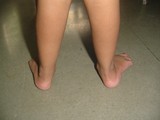Cerebral palsy is seen in 2-3/1000 live births. Cerebral palsy can be caused due to injury to immature brain either in mother’s womb, during birth or after birth. Maternal infections like rubella, herpes, cytomegalovirus toxolplasmosis increases the risk of cerebral palsy. Hypoxia occurring during birth or after birth can also lead to cerebral palsy. Preterm children and low birth weight (<1500 gram) have increased risk. Injury to brain, meningitis and encephalitis also leads to cerebral palsy. Depending on level of involvement it is divided as:
- Monoplegia: involvement of one limb Hemiplegia: involvement of one side of the body
- Diplegia: involvement of both lower limbs with minimal involvement of the upper limbs.
- Paraplegia: implies no upper limb involvement only lower limb involvement
- Triplegia: involvement of one side of the body, as in hemiplegia, combined with involvement of the contralateral lower limb. The lower limb involvement is always asymmetrical.
- Quadriplegia: involvement of all four limbs and the trunk
The goals of orthopaedic surgery in a non ambulatory patient are well reduced stable hips and straight spine with good hand function. The goals of orthopaedic surgery in a walking child are stable plantigrade feet, straight knees and stable hips. The problems that frequently need treatment are:-
Foot problems. Valgus feet (outward turned feet) are common. They happen because of tight tendoachills and midfoot break. It often requires calcaneal lengthening or fusion of foot bones. Varus deformity (feet turned inward) may also develop because of spastic tibialis anterior and posterior which may require botulinum toxin injection, lengthening or transfer.


Searching for Cerebral Palsy treatment in Pune? Dr. Sameer Desai, a leading Pediatric Orthopedic Surgeon, offers specialized care, including Botulinum Toxin A therapy, physiotherapy, and surgical interventions to improve mobility and muscle function. Visit Surgicare Hospital for expert treatment.
